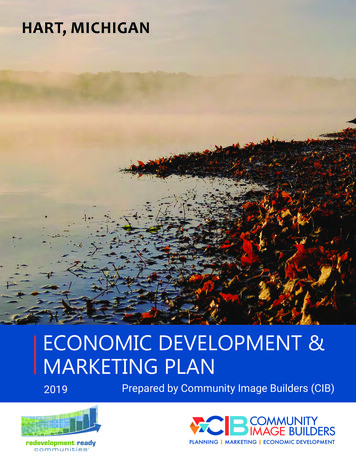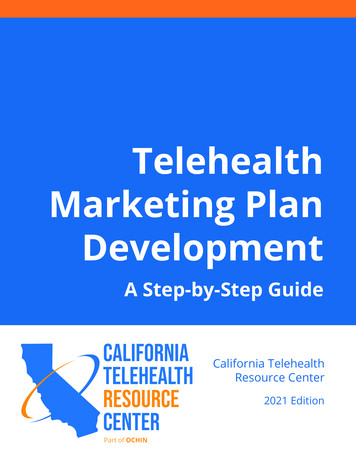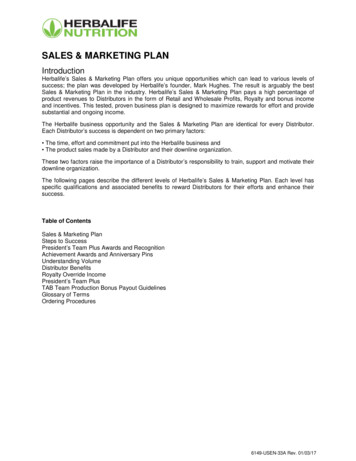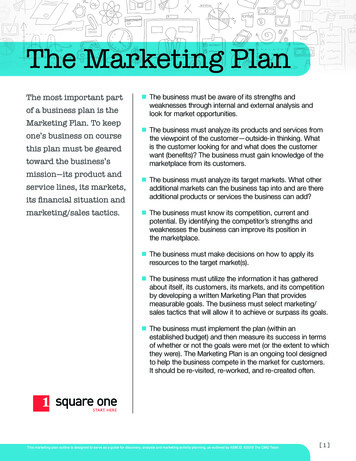
Transcription
HART, MICHIGANECONOMIC DEVELOPMENT &MARKETING PLAN2019Prepared by Community Image Builders (CIB)
ACKNOWLEDGEMENTSThe City of Hart would like to acknowledge and thank the followingindividuals for their support in preparation of this EconomicDevelopment and Economic Development Marketing Strategy.Lynne Ladner – City ManagerPatrice Martin – TIFA/City Council/Hart Bed and BreakfastAl Martin – Planning Commission/Hart Bed and BreakfastRob Splane – Tech Company/City CouncilSteve Bruck – TIFA/Power Board/Voya FinancialJulie Kreilick – Main Street* DirectorJodi Nichols – Right Place/OCEA Business DevelopmentRon Steiner – Starting BlockMark Platt – Hart Public Schools/Spectrum Health BoardDavid Jirousek – Horizon Planning/City PlannerThis Economic Development and Marketing Strategy has beenfunded in part by a grant from the Michigan Economic DevelopmentCorporation as part of the Redevelopment Ready Communities Program.*As of January 2020, Hart graduated from the Main Street program. The efforts andresponsibilities formerly managed by the program will transition to the Hart Economic AndRedevelopment Team (Heart), a provisional name for the organization at the time of this writing.
Table of ContentsEconomic Landscape5Planning Process5Income, Employment and Education6Regional Economic Development 8SWOT Analysis9Goals and Objectives12Implementation13Redevelopment Strategies14Why Hart?14Action Table 15Background: Best Practice 5.2.119Marketing19Approach21Key Challenges 21Economic Development Marketing 22Target Market Segments for Economic Development22Economic Development Target Market Messaging Chart 24Getting the Message Out26Online Tools 26Recommendations for Online Tools 26Social Media 2828Economic Development: Earned Media & Public RelationsEconomic Development: Strengthening Relationship with Silver Lake Chamberof Commerce 29Economic Development: Agritourism29Economic Development: Events3030Economic Development: Redevelopment Sites MarketingTraining/Workforce Development 30Post-Secondary Education Millage 30Outreach and Partnership31
Vocational Training 31Proposed Actions 32Destination Marketing33Destination Marketing: Proposed Actions33Destination/Tourism: Festivals35Benchmarking, Metrics and Ways to Track ProgressStriking a Balance 36Appendix37Project Brief 4235
PLANNING PROCESSThis economic development strategy for the City of Hart is a collaborative planning project between theMEDC’s Redevelopment Ready Communities program and the City of Hart. The result of this project willbe an economic road map to assist with job creation, marketing and branding along with redevelopmentand investment strategies for the community. These actions will both strengthen and diversify the localeconomy. The road map will also help guide the coordinated effort between Prosperity Region 4, OceanaCounty and the City of Hart to work in a cooperative manner that will integrate aspects of the regionaleconomic development strategy with the local economic development effort.When creating an economic development strategy, it is important to answer several questions.1.2.3.4.5.6.7.Who are the largest employers in the community?What drives the local economy?What is the city’s role in the larger region?What are the strengths of the community and how can they contribute to growth?What could be potential challenges to growth?What overall image is the city working to create?What strategies can be implemented to execute the end vision?As part of the planning process, a local steering committee has been assembled comprised of localleaders, businesses and other key stakeholders with a direct interest in the economic success of theCity of Hart. The steering committee will help guide the development of the overall strategy, as wellas provide critical input on the future economic vision for the city. Lastly, the steering committee willassist with the identification of implementation projects throughout the community which can bebenchmarked and monitored for success.Economic LandscapeThe City of Hart is located in northwestern section of Oceana Countyalong US-31 The city is surrounded byHart Township. The current populationof the City of Hart is 2,275 accordingto 2017 US Census estimates with58% of the current population withinthe work age group between 16 and65 years of age. Of that percentage,54.7% are active in the labor forcewith 45.3% not currently active in theFigure 1labor force for any number of reasons.Currently, the US labor participation rate is 62.7%, which Hart is considerably lower.Historically, labor participation rate has been a good indicator of the strength or weakness within a locallabor market. The higher the rate, the greater the availability of quality employment opportunities.
Since the last recession, labor participation rates have generally been in decline, locally, regionallyand nationally, but not because of reduced employment opportunities. During the recent recession, aconsiderable number of workers thatFigure 2became unemployed permanentlyleft the labor force. As employmentopportunities declined, it becamemore difficult for workers aged 55 to find meaningful employment, somany either took part time work,worked off the record, signed upfor permanent disability or simplyretired.To better understand the decline in labor participation, we need to look at the age distribution within the City of Hart and surrounding communities. At quick glance, the population is getting younger, a sight not seen across many communities in Michigan. This demonstrates that the city still has a younger population for employers to draw workforce from.Secondly, while the largest age cluster is 65 , the 10-29 age group is nearly equal in size. This shows thatnumerous residents within the city have families. Of the 877 total households within the city, 64.3% arefamilies, leading us to believe that families are choosing to reside in the City of Hart for a great qualityof life along with a good school system.Given the large age bracket between 10and 29 years of age, it is anticipated thatthis trend will continue into the futureFigure 3: Age Distribution, City of Hartshould conditions remain consistent going forward.Figure 4Figure 3: Age DistributionIncome, Employment and EducationThe median household income in the City of Hart, 31,326 isrelatively lower compared to Oceana County at 44,382.When you look deeper in to the income data, understandingthat many of the available jobs within the city revolve aroundtourism, customer service and food processing. Given thisthe average wage for these types of industries generally hovers around minimum wage ( 9.25/hour in Michigan), it makes sense that the median income within thecity is lower in general compared to the county and state. The addition of new manufacturing in theindustrial park should help increase wages in the city, especially as the park grows to full capacity. Looking at families, the median household income for families is 40,385.6
Figure 5Median non-family income is 18,935 which would generally be a single income, head of household. Anotherkey statistic that could be reducing the overall medianincome in the city is that 37.1% of the earning populationis drawing some level of Social Security Benefits with amean income of 16,000.Looking at the educational attainment of the City of Hart,a large percentage of the population (46.2%) has completed some level of higher education. It is important to note however that both Oceana County (11.2%)and the State of Michigan (17.1%) are out pacing the City of Hart (9.2%) for bachelor’s degree attainment. One of the issues identified during the community SWOT session is the overall lack of availabilityof higher education throughout all of OceanaCounty.Figure 6When looking to grow the economy of anycommunity, it is extremely important to havea highly skilled and educated workforce. Thishas been identified as the highest priorityfor employers when seeking to expand theiroperations. It has also been identified as atop priority by the Governor for the State ofMichigan.The landscape of Oceana County varies greatlyincluding thousands of acres of productiveFigure 6farmland, international transportation routes such as US-31 along with several vital smallercities, townships and villages. Despite the county’s diversity, it’s residents and businesses share manyof the same opportunities, assets, and challenges that can be more effectively acted upon with acoordinated effort.Figure 7The State of Michigan and many of its communitieshave been emerging from one of the most extensiveeconomic recessions on record since the GreatDepression. At its height, unemployment topped7.8% across the state. Locally, unemployment wasn’tnearly as high as seen in the Figure 6, but the samepattern was present as identified regionally, acrossthe state and across the nation.Looking at the industry of the City of Hart, the largestemployment sectors for residents of the city fall inthe categories of manufacturing and health care andsocial assistance.7
It is important to note, that while figure 7 identifies the industries of employed workers in the City ofHart, it is not wholly indicative of the industries found within the City of Hart. A full list of industriesidentified within the city itself can be found in the appendix of this plan.It is also important to understand where workers are going and where they are coming from. Of the837 workers estimated by the census living in the City of Hart, 46.8% of them work within the city. Theremaining 53.2% work outside of the city proper, yet not too far from the city. The median commutetime for workers in the city is 14 minutes, or roughly 10 miles from the city.Regional Economic DevelopmentWest Michigan Regional Prosperity AllianceThe City of Hart and Oceana County are a part of Michigan’s Prosperity Region 4. The Regional ProsperityInitiative (RPI) is a voluntary process formed by former Governor Rick Snyder to create vibrant regionaleconomies. The Governor identified ten regions throughout the state and asked leaders from the sectorsof regional planning, adult education, workforce development, economic development, transportation,and higher education to pursue activities that promote prosperity. Region 4, also known as the WestMichigan Prosperity Alliance (WMPA) is comprised of 13 counties: Allegan, Barry, Ionia, Kent, Lake,Mason, Mecosta, Montcalm, Muskegon, Newaygo, Oceana, Osceola, and Ottawa.A major focus of the West Michigan Prosperity Alliance’s (WMPA) Prosperity Plan is to identify projectsof regional significance. Since 2013, WMPA has received over 1,000,000 in grant money, helping tofund more than 16 projects of regional significance. The process of selecting projects included a callfor project submission with specific evaluation criteria requirements sent out to over 1,000 agenciesand individuals; review of projects to determine if requirements were met, and then public voting atregional summits.Oceana County Economic Alliance/The Right PlaceThe Oceana County Economic Alliance is an organization created to assist business development needsin Oceana County, and is a partner with The Right Place. Services offered to current and prospective newbusinesses include: financing, site selection, research information, education, networking opportunitieswith economic development agencies, workforce development, and trade. Its mission is to create adiverse economic environment by strengthening talent, leveraging resources, and supporting retention,expansion, attraction and creation of Oceana County businesses.City of Hart Tax Increment Finance AuthorityThe City of Hart Tax Increment Finance Authority was established in 1983 to serve as an economictool to assist with reinvestment in the City of Hart. The TIFA was extended in 2012 for 15 years to endin 2027 unless it is reauthorized and extended again at that time. TIFA districts capture incrementalgrowth as a result of increasing property values and investments made in the district above and beyondthe established base value if the district. These captured revenues can then be utilized to assist withfinancing public improvements within the district. This district can be a great tool to catalyze newdevelopment or reinvestment opportunities within the city.8
SWOT AnalysisOn March 12th, 2019, the City of Hart Economic Development Steering Committee completed as SWOTAnalysis as a way of obtaining perceptions of the city’s strengths, weaknesses, opportunities and threats.The intent of the sessions was to gain insight, but more importantly, to establish a community identityand how the city fits into the larger region.Strengths Lake in DowntownProximity to Lake Michigan/Silver LakeSignificant Tourism economyCounty SeatProximity to State HighwayIndustrial ParkLand available for industrial growthIntact Historic DowntownHart Montague TrailYear-round Recreational optionsFood ProcessingFood GrowthStrong Public SchoolsRobust municipal utilitiesWaterSewerPowerBuilding Entrepreneurial SupportActive group of core supportMichigan Works in CountyActive CET programStrong intergovernmental collaboration with County and surrounding communitiesMigrant WorkforceBusinesses work well togetherReasonable cost of livingBeautifulEasy to work with CityClose to metro areas – GR, Muskegon, CadillacStrong Health care service birth to deathRecent website updatesconnections to Silver Lake Sand DunesSilver Lake/Hart Chamber of CommerceJGP Campground and ParkAggressive Park PlanningDowntown Pocket ParkHart Commons9
Farmer’s MarketSummer concert seriesHart Historic DistrictBi-lingual workforce populationEmployer Resource NetworkWorkforce housing and subsidized rentCity Financially Sound/Strong City BudgetSafe place to beMichigan Opportunity ZoneStrong Community Foundation – Career Access NetworkWeaknesses Housing ShortageOlder Housing StockHousing Stock – single family detachedNo Post-secondary education resources in countyWorkforce – education primarily high schoolPopulation baseHard to attract businesses/programsDeath out paces Births – population shrinkingNo Champion for post-secondary workforce developmentLack of high paying jobs/jobs requiring higher educationAmazon effectLowest income in state/county-wideAbsentee landlordsTax Payer initiatives competing with businessesLack of community appeal/no community promotionLack of quality of life – cultural opportunitiesLack of a shared vision for communityConservative/Lack of Forward thinkingCulture of this is the way it has always been doneGood ol’ Boys networkOpportunities 10Michigan Opportunity zoneSmall Biz Centric ChamberRecreational Marijuana industryRecreational OpportunitiesDevelop Pro-growth culture changeCulture ShiftCultivate greater collaborationOrganization to organizationHart Economic And Redevelopment Team (Heart)Starting Block
SchoolsOceana Home PartnershipCouncil on AgingAvailable Industrial, Commercial and Residential develop-able landAffordable workforceOpportunity for vertical mixed-use development in downtownOpportunity to expand fiber internet – Great Lakes EnergyUtility ReliabilityUtility expansion availableRecip Plant (natural gas)Incentives PolicySewer/Water/ElectricCapitalize on Hispanic PopulationEmbrace diversity that’s hereTouristsPeople moving hereConnect Hispanic communityBigger presence of SBDCExisting Brick and Mortar vacant structuresGales IGAShopkoDiversify industryIndoor recreation optionsThreats Dependent on one major tourism driverHart Lake threatened by Federal RegulationsCity economy based upon one sector – food growth/processingCompetitionLosing what workforce we have to other areasAging PopulationTalent Recruitment (school and healthcare)County government privatizing servicesCity and County vision and goals not alignedBest & Brightest are leavingGrass is always GreenerMigrant workforce disruptionCounty elected officials – archaic/not willing to adaptResistance to growth/changeFixed mindsetLack of transportation optionsSeasonal/Weather dependent economyLack of intergovernmental collaborationHart, Pentwater, Shelby, Silver Lake11
Goals and ObjectivesGoals are high level policy statements that drive future decisions around projects and investmentopportunities that can contribute to community growth.Objectives are specific ideas, strategies, policy statements or projects that achieve goal results. Theobjectives identified in this plan will assist the City of Hart by providing measurable tasks that revolvearound increasing economic activity within the city. Further these objectives will support other planningefforts in the city such as the Master Plan, the Hart TIFA, Hart Economic And Redevelopment Team(Heart), along with future capital improvement plans. Integrating all the above planning efforts with acommitted leadership will be the most important driver of success for the community.EducationGoalsObjectives Have the city reconsider passing a millage for both West Shore andDevelop andMuskegon Community Collegesenhance Identify apprenticeship opportunities for residents not looking atpartnershipshigher educationwith educational Partner with Michigan Works to drive residents to job traininginstitutions fromopportunitiesK-12 through post Support Ottawa County Skills for Success Program (byproduct ofsecondaryMarshall Plan). Soft skill training program for all age groupsInfrastructure Develop acost effective,consolidatedinfrastructuresystem 12CollaborationRegional Strengthenexisting and createnew collaborativepartnerships tooperate effectivelyas one voice forregional economicsuccess. High-speed Broad Band connectivity throughout the communityWork with Connect MichiganPrioritize internet connectivity as part of the infrastructure planwithin the City of HartExpand public water and sewer to un-served city locationsEngage in dialog with surrounding communities regarding sharedservices to stretch limited community resourcesContinue to prepare short and long-term capital improvementprograms covering major infrastructure and facility needsConsider traffic calming measures as opportunities arise, particularlyin neighborhoods and downtownContinue support of the Michigan Energy Optimization ProgramEncourage neighborhood and development connectivity for streetsand non-motorized transportation to ensure a more efficient andconvenient transportation networkImprove electric reliability to maintain our reduced downtime duringoutages and improve peak generation capacityCollaborate with the West Michigan Shoreline Regional DevelopmentCorporation (5 county EDO recognized by EDA)Expansion of regional activitiesImprove communication regarding regional economic developmentopportunitiesCity to host intergovernmental joint meetings to discuss regionaleconomic development and goals and issues related to economicdevelopment and tourism
DestinationIndustry Activities Develop anecosystemfor creating,attracting,expanding,and retainingbusinesses. Continue effortsto make Hart a destination citywith a high quality of life.Continue to work with agribusiness and encourage them to considerbusiness expansion opportunities such as agritourism, cidery, wineryand orchard toursAgribusiness relationship buildingBusiness incentive program and policy for business attraction,retention and marketing.Entrepreneurial ecosystem/support/development programAccess business retention program through The Right Place and thecountyWork with PTAC to assist companies in the citySBDC representationUtilize the Hart Economic And Redevelopment Team (Heart) as anadvocate to draw tourism and investment in Downtown Hart.Identify additional events to attract tourists and residents fromoutside of the area to the City of Hart.Create a targeted marketing campaign to attract businesses, touristsand new potential residents to HartImplementationThis plan serves as the policy guide for moving Hart forward, guiding decisions about future physical andeconomic development. Transforming the plan’s goals into reality will require a long-term commitmentand political consensus. The plan is designed to be a road map for action, incorporating strategies,specific projects, and programs that will achieve the desired results.This chapter synthesizes the many plan recommendations and identifies the actions and timing neededto transform the plan’s vision into reality.Tenets of Successful ImplementationThe input received through the master plan process provided a foundation to help achieve the city’svision, community support, commitment, and involvement must continue.CommitmentSuccessful plan implementation will be directly related to a committed city leadership. While electedand appointed officials will have a strong leadership role, many others - city department directors, staff,and leaders from the community’s many institutions and organizations - will also be instrumental insupporting the plan.However, commitment reaches beyond just these individuals and includes the array of stakeholders.Citizens, landowners, developers, and business owners interested in how Hart develops must unitetoward the plan’s common vision.Integrate with Project DesignCity officials and departments must embrace the plan, applying its recommendations to help shapeannual budgets, work programs, and the design of capital improvements. For example, the City’sengineering practices can support implementation through infrastructure improvements, streets, andstorm systems designed consistent with plan policies and recommendations. Each department, staffperson, and elected official should find it a benefit, if not an obligation, to reference the plan whenmaking decisions and setting priorities.13
Guidance for Development DecisionsThis plan is designed for routine use and should be consistently employed during any process affectingthe community’s future. Private investment decisions by developers, corporations, and land ownersshould consider the plan’s direction as it is the guide for economic growth and stability of the communityand supports the goals and objectives of the overall master plan.Evaluation and MonitoringThis plan has been developed with a degree of flexibility, allowing nimble responses to emergingconditions, challenges, and opportunities. To help ensure the plan stays fresh and useful, periodic reviewsand amendments may be required. This will ensure plan goals, objectives, and recommendations reflectchanging community needs, expectations, and financial realities.Redevelopment StrategiesHow to Attract Developers?Developers typically look for project locations where the potential for success is fairly certainand risks limited. This means that they are attracted to communities with strong markets wherethe infrastructure is in place, reasonably-priced, quality development sites are available, and thedevelopment review process is quick. They also look for opportunities to enter a market right beforeit “takes off” and capture the heavy demand and associated real estate price or rent increases.Good developers are usually inundated with requests from municipalities and TIFA’s to develop intheir community, citing the advantages they can offer. Yet only a small percentage of communitiesprovide the information necessary to interest developers. There is specific information theylook for that will minimize the amount of time it takes to make a go- no-go decision. For example,is there a market for the type of development being sought by the community? What is therole of the community within the region (i.e. bedroom community, employment destination,transportation hub, etc.)? Are reasonably priced sites available for development of redevelopment?Is necessary infrastructure in place or will this be needed and add to the cost of the project?How accessible is the development location and how large a market area can they draw from?These are all vital questions that can be partly answered by the community, making it easier to piquethe interest of a developer. Time is money and the less time developers have to commit to looking ata project/community, the more likely they are to dig deeper and hopefully show interest in movingforward. Some of this information might already be available while additional work is needed togather the remaining data. It is up to the City, TIFA, business leaders, and civic associations to worktogether to assemble developer information and then actively recruit developers and businesses.Why Hart?Since developers look for strong or emerging markets, Hart must prove that it fits into this classificationand may have just been overlooked. What are the positives with Hart that have created unmet demand forhousing, commercial, office or industrial uses? This is information that must be gathered and uncoveredto create the “elevator speech” for developers: meaning why invest in Hart as opposed to all the othercommunities that contact you? Also, what has changed in recent years causing the private sector to overlook14
the City as a place to develop? A one-page handout summarizing this key information will be a good start.After that, a separate sheet can be created for each marketing item like housing, retail, office, hospitality, etc.Understand the MarketDevelopers may not take the time to fully understand the dynamics of the local market and especiallynot unmet demand. The City can prepare a fact sheet for different market segments, working withlocal real estate professionals and companies. For example, some compelling information might beincreased housing prices and vacancy rates; potential demand for certain types of housing usingthe Target Market Analysis; voids in the retail market that could be served by local businesses, etc.Developer MatchmakingOnce the above information is collected and organized, invite developers to come in and learn aboutavailable sites and why they should consider Hart for their next project. It would be best to invite themindividually and be concise, enthusiastic, and to the point with what you would like them to consider.Be sure to share success stories from other companies and developments so they can see that othershave already tested the market. It is equally important to have as much information available regardingproperty availability, price, rental rates, recent purchase prices, traffic volumes, etc. This will provide apositive impression regarding the recruitment effort and limit the number of items that need follow-up.TIFA/City Property AcquisitionProperty acquisition will be a necessary part of implementing the development projects containedherein, particularly for site development and redevelopment. By purchasing property in an areaidentified for new development, the TIFA or the City will have an added tool to attract developers andbuild the desired project. For example, to develop new housing, the TIFA or City can acquire severalof the vacant lots and can contribute them to the project. This will provide an incentive to lower thecost, and minimize the risk, for the developer. Should the first phase be successful, the developer willmore than likely undertake construction of additional units without any form of subsidy. The goal is touse tax increment financing to attract developers by minimizing risk, leverage private investment andeventually eliminate the need for financial assistance.Gap FundingSome projects may need financial assistance to kick-start the development. The City may, at its owndiscretion, commit project-specific future tax increment capture back to private projects for a specifiedperiod of time. The goal is to provide funding to close the “gap” that prevents the project from becominga reality due to financial feasibility. There are many additional incentives that can also be utilized tosupport “gap” funding.Action TableFor the City Economic Development Strategy to be an effective document for the next several years,steps must be identified to guide community leaders towards implementation. This chapter summarizesthe goals and the recommendations described throughout the plan and serves as a quick reference forthe City Leadership and others to monitor progress or serve as a checklist for implementing the plan.The following table identifies major steps and projects designed to maintain and improve the City ofHart. Implementation of these items will have a positive impact on the character and vitality of the15
community. Many of the implementation recommendations presented herein will require the closecooperation of many bodies. The final column in the table indicates the primary group(s) responsiblefor implementation.ActionInfrastructureFormalize the annual CIP development process and tiespecifically to the Master Plan and Economic hance streetscaping with landscaping, lighting, signage,wayfinding and sidewalk improvementsLincoln Street reconstruction2020Administration, City Council,TIFA, Planning Commission, HartEconomic And Redevelopment Team(Heart)City Council, TIFA, Hart EconomicAnd Redevelopment Team (Heart)City Council, AdministrationEnergy generation assessment2020City Council, AdministrationWatermain transmission upgrades and replacement2020City Council, AdministrationRegional transportation growthMid-termCity Council, AdministrationEducationResearch a county-wide millage to support communitycollege expansion within Hart and Oceana County.Mid-termCity Council, Administration, SchoolDistrict, Oceana College AccessNetwork, Oceana CountySchool District, Administration,The Right Place, Hart EconomicAnd Redevelopment Team (Heart),Oceana College Access NetworkIdentify additional ways to connect local graduatingstudents to employment opportunities within the City ofHartEconomy & Business DevelopmentContinue working with developers and property owners todevelo
This Economic Development and Marketing Strategy has been . funded in part by a grant from the Michigan Economic Development Corporation as part of the Redevelopment Ready Communities Program. *As of January 2020, Hart graduated from the Main Street program. The efforts and










